T.F. CHEN“Post Van Gogh Series”
Lucia Gallery ARTFORUM Nov 91 -Thomas McEvilley
 Chen's practice, of course, has resonances beyond or in addition to those of a Western appropriator. Chinese tradition has gone through something like the developmental cycles involved in European history at least a couple of times. With such a surfeit of history, Chen is more involved with such passionately dark obsessions as the death of the past. Chen's special preoccupation with Van Gogh along with Jackson
Chen's practice, of course, has resonances beyond or in addition to those of a Western appropriator. Chinese tradition has gone through something like the developmental cycles involved in European history at least a couple of times. With such a surfeit of history, Chen is more involved with such passionately dark obsessions as the death of the past. Chen's special preoccupation with Van Gogh along with Jackson  Pollock- the quintessentially self-expressive examples of individualism in Modern art in the West- suggests an attempt to rearrange not just his work but his self. In both his life travels and in his art he has made himself a cross- or multicultural individual, to suggest the citizenry of an age to come- or at least one idea of what such a selfhood might be.
Pollock- the quintessentially self-expressive examples of individualism in Modern art in the West- suggests an attempt to rearrange not just his work but his self. In both his life travels and in his art he has made himself a cross- or multicultural individual, to suggest the citizenry of an age to come- or at least one idea of what such a selfhood might be.This exhibition featured Chen's "Post-Van Gogh" series- a set of 100 oil paintings involving images borrowed from Van Gogh in a reconceived universal history in which all times and things psychedelically mingle. In one picture Vermeer works on a half-finished canvas of Van Gogh irises. In another, a Gauguin-style Polynesian nude lies wistfully above a scene where Cezanne's Boy in a Red Waistcoat, 1888-90, sits at table with his colors, sits by a table on which a Cezanne still life lies. Paintings by Matisse and others hang behind him.
 VINCENT IS COMING HOME /44X66’’/ac/ IV-90 VINCENT IS COMING HOME /44X66’’/ac/ IV-90 |
 ANDY JUST LEFT/50X72’’/ac with collage/ IV-90 ANDY JUST LEFT/50X72’’/ac with collage/ IV-90 |

Homage to Vincent van Gogh (triptych)72X150’’/ ac/ II-V-91
Chen learned about Western Modernism through Japanese art books, which he saw while in high school in Tainan. He says he wept with recognition when he saw the Van Goghs. Now the "Post-Van Gogh Series" is traveling to 18 defferent venues in Taiwan. Perhaps there will soon be other post-Modern artist there.-Thomas McEvilley
The Five-Dimensional Apocalypse of T.F. Chen
by Smith except from TF Chen’ philosophy
For East & West series
 All of us live comfortably in a physical three-dimensional world. Although we don’t begrudge accepting time as the fourth dimension, most of us throw up our hands when confronted with any theoretical mathematical constructs that add more dimensions. When Dr. Chen talks about Five Dimensional Universal Civilizations, he is not invoking parameters as we usually think of them. He is giving some new meanings to some old words. Since these meanings unhide the apocalyptic structure of his New-Iconography, it is intriguing to unravel them as best as we can.
All of us live comfortably in a physical three-dimensional world. Although we don’t begrudge accepting time as the fourth dimension, most of us throw up our hands when confronted with any theoretical mathematical constructs that add more dimensions. When Dr. Chen talks about Five Dimensional Universal Civilizations, he is not invoking parameters as we usually think of them. He is giving some new meanings to some old words. Since these meanings unhide the apocalyptic structure of his New-Iconography, it is intriguing to unravel them as best as we can.Let us start with an easy four dimensional look at the Western world Chen discovered in Paris. Chen’s eye and mind discerned four societies that led to the modern West. He gave each a visual symbol—hence, four dimensions of his defining.
He let the pyramid symbolize the essential of Egyptian civilization, which was geometric, firm, collective, immobile, hierarchic, stubborn, and sealed off, with a preoccupation for abstraction, stylization, and eternity.
He depicted the Greeks with a series of vertical lines, representing columns. The ardent Greek spirit evoked a passion for liberty, clarity, democracy, eloquence, personal development, proportional beauty, harmony, equilibrium, and a search for ideals.
 Venus and Shogun/ #78009 / 50X 72″/ ac Venus and Shogun/ #78009 / 50X 72″/ ac |
 Enriching East West(B)-Mixed Media on paper-30X40''-1994.4 Enriching East West(B)-Mixed Media on paper-30X40''-1994.4 |
As to Judeo-Christianity, he used the Christian cross as a symbol of one true God, a soaring verve, sacrifice to the point of martyrdom, mysticism, and ideal of personal salvation.
Chen saw these four symbols being pushed together until they synthesized a composite Western civilization, a new fifth dimension, which he depicted schematically as a sort of cathedral: a series of columns supporting a pyramidic pediment circumscribed by a dome-like arch, supporting a skyward cross.
 Old new East West Painting writing (B) / 158.3×129cm
Old new East West Painting writing (B) / 158.3×129cm |
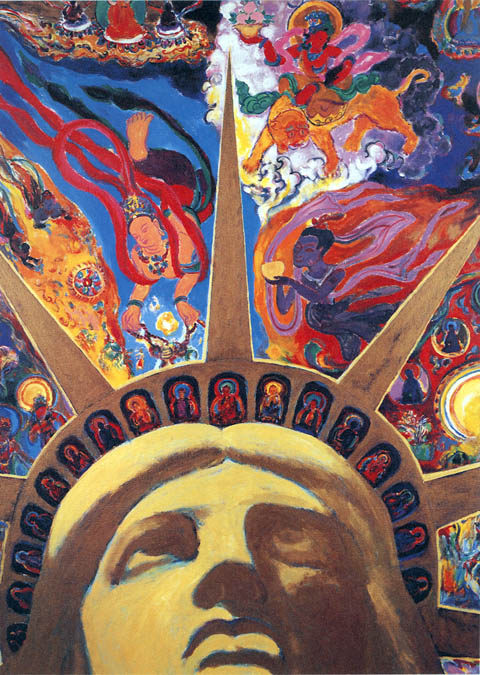 Greetings From The East /66x48’’ / ac
Greetings From The East /66x48’’ / ac |
 Inside, the gallery showcases a rotating exhibition by different artists associated with the NWAC. In 1996, the Center opened with a retrospective of Chen’s work t date, reflecting a career spanning 45 years, from 1951 to the post-modern “Neo-I” art. dubbed the prophet of neo-iconography by critic Lawrence Jappson in 1978, T.F. Chen’s paintings are based upon the creative manipulation of readily recognized images. “Art and society,” according to Jeppson, “are held together by a matrix of shared visual experiences,’ Chen thus becomes “an exciting matchmaker of West and East, seeking to bind a fragmented world with his art.”
Inside, the gallery showcases a rotating exhibition by different artists associated with the NWAC. In 1996, the Center opened with a retrospective of Chen’s work t date, reflecting a career spanning 45 years, from 1951 to the post-modern “Neo-I” art. dubbed the prophet of neo-iconography by critic Lawrence Jappson in 1978, T.F. Chen’s paintings are based upon the creative manipulation of readily recognized images. “Art and society,” according to Jeppson, “are held together by a matrix of shared visual experiences,’ Chen thus becomes “an exciting matchmaker of West and East, seeking to bind a fragmented world with his art.”
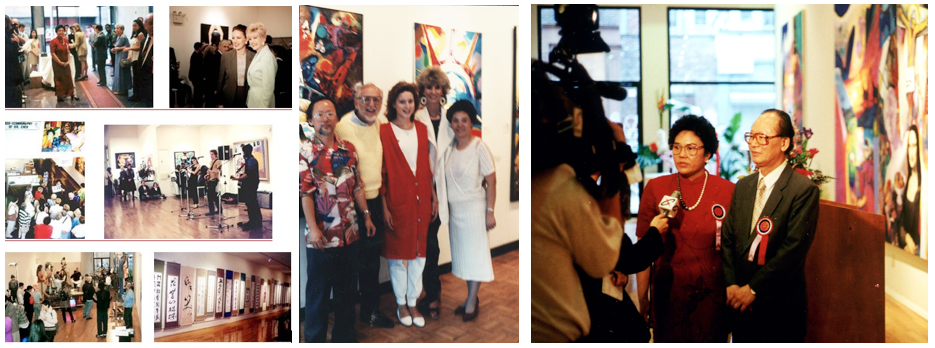
Lucia Curated many art shows for New World Art Center /Warner Brother movie producer: David Wolper & family take photo with Lucia and TF Chen/ Media Interview T.F.Chen &Lucia during the museum opening
Born and raised in Taiwan, T.F. Chen is himself a product of Eastern and Western influences. In 1963, Chen went to Paris on an art scholarship offered by the French Government, and spent the next 12 years earning his Ph.D. in art history at the Sorbonne and studying painting at the Ecole des Beau-Arts. During this period, he also wrote books and magazine articles on art for publication in his homeland where they were ready eagerly by other Taiwanese who were becoming increasingly oriented toward Western culture. Among them was Chen’s future wife, Lucia. The two finally met in Paris and got married in 1975. Lucia Chen is a formidable woman, who one art critic calls “the mediator between Dr. Chen and the outside world.” Educated at Taipei Normal College, the University of Paris and the University of Maryland, Lucia entered the esoteric international art scene with virtually no knowledge of art, but emerged 20 years later art dealer, agent, advisor, publisher and collector. As if that isn’t enough, Lucia also devoted much of her seemingly boundless energy to writing numerous articles on the international art market and collecting African art and master prints. After relocation to the U.S., the couple started a family in Maryland with the birds of their son Ted and daughter, Julie. Then in 1980, in part to launch a campaign t further her husband’s career as a painter, Lucia opened her first gallery in their home in Georgetown with money borrowed from friends and relations.
“In those days, I went to every international art fair and exposition in the country,” she recalls. “It was a very hard life – packing, shipping, setting up booths, re-packing, shipping, going to New York, to California, coming home, then going off again right away.”
After relocation to the U.S., the couple started a family in Maryland with the birds of their son Ted and daughter, Julie. Then in 1980, in part to launch a campaign t further her husband’s career as a painter, Lucia opened her first gallery in their home in Georgetown with money borrowed from friends and relations.
“In those days, I went to every international art fair and exposition in the country,” she recalls. “It was a very hard life – packing, shipping, setting up booths, re-packing, shipping, going to New York, to California, coming home, then going off again right away.”News from Fingerhut group
 What exactly is Neo-Iconography? Lawrence Jeppson, the art critic and consultant for the Smithsonian Institution who coined this term said: “Neo-Iconography is a stunning paradox: an artistic symbolic resplendence that thrusts deeply into the esthetic future by appropriating every sort of image recognized from the past. This incandescent creator of Neo-Iconography, Dr. Tsing-fang Chen, relentlessly manipulates every variety of image from the public experience to create new realities, esthetic astonishments, and psychological/philosophical collisions!”
So, Neo-Iconography is a synthesis of many ideas and images. At the heart of this style is Dr. Chen’s perception of the future of world culture: the “Five-Dimensional Universal Culture,” which he formulated into a kind of cultural theory in 1969, getting revelation from the American astronauts’ landing on the Moon.
What exactly is Neo-Iconography? Lawrence Jeppson, the art critic and consultant for the Smithsonian Institution who coined this term said: “Neo-Iconography is a stunning paradox: an artistic symbolic resplendence that thrusts deeply into the esthetic future by appropriating every sort of image recognized from the past. This incandescent creator of Neo-Iconography, Dr. Tsing-fang Chen, relentlessly manipulates every variety of image from the public experience to create new realities, esthetic astonishments, and psychological/philosophical collisions!”
So, Neo-Iconography is a synthesis of many ideas and images. At the heart of this style is Dr. Chen’s perception of the future of world culture: the “Five-Dimensional Universal Culture,” which he formulated into a kind of cultural theory in 1969, getting revelation from the American astronauts’ landing on the Moon. 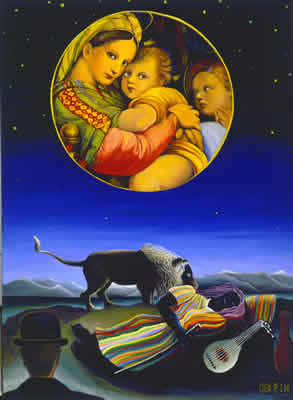 light of love-oc-66X48''-1994.1 light of love-oc-66X48''-1994.1 |
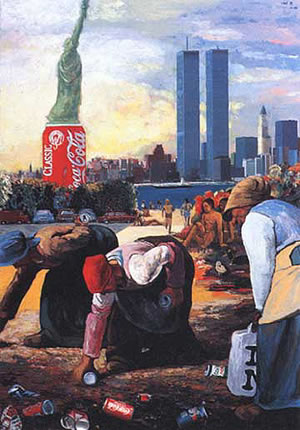 City Gleaners / 72X50”/ ac City Gleaners / 72X50”/ ac |
 Confrontations Confrontations |
 Venus And Shogun Venus And Shogun |
4 Silkscreen published by Finger Hut Group…
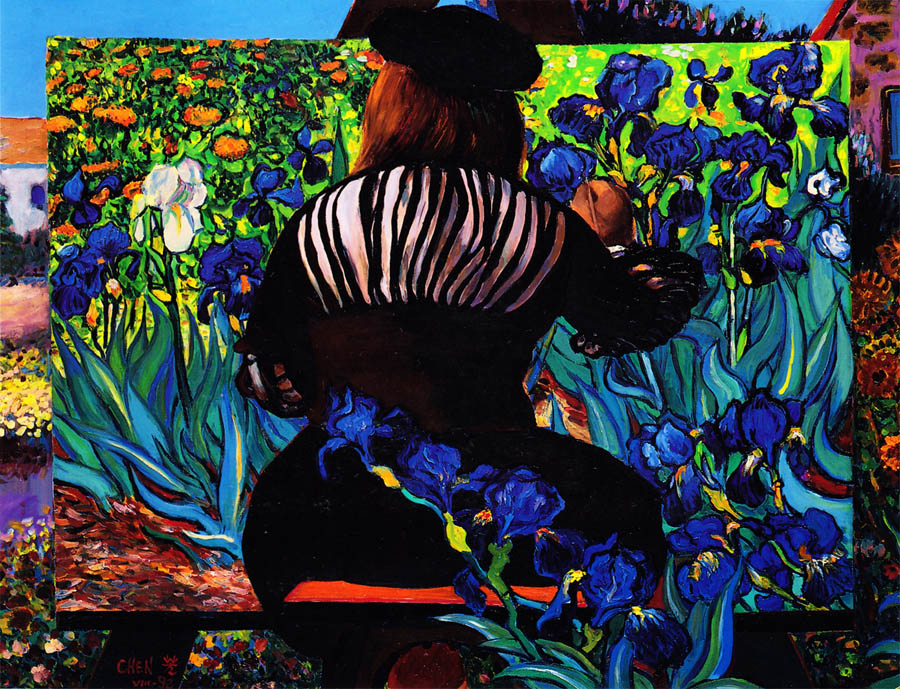
Dr. T. F. Chen: “Painting Irises (II),” 1993 screen print, 30x40.” Taken from 1992 o/c.
In the late 1980s, the van Gogh painting “Irises” was purchased at auction for the astronomical, record-breaking sum of $80 million. This was a historical event in the art market. Yet how could this come to pass? As Dr. Chen’s image reveals, the painting is unfinished! Van Gogh, dressed as an artist from Holland, is seated in a sunny Arles garden, still adding dazzling, pure strokes of color to the canvas. We do not see his face, hinting perhaps that the nature of the artist is less significant than the nature of the art. Indeed, the greatest artist of all is obscured from human vision, but with a divine hand, continues to add strokes of color to the canvas known as Earth.
Dr. T. F. Chen: “Love Above Confrontation,” 1993 screen print, 30x40.” Taken from 1984 a/c.
A span of four centuries of changing values in artistic tradition electrifies the air between Titian’s “Venus with a Mirror” and Picasso’s “Seated Woman.” The contemporary viewer can see the beauty in both icons, but within their worlds, each woman argues for the authenticity of the stylistic expression of her image. Locked in a moment of confrontation, the two do not comprehend that another world exists that values and cherishes both for their differences, not in spite of them. Through an open window, Chagall’s folkloric pair of lovers float high above the fray. They seem to advocate “love above confrontation,” and are enjoying the freedom that only love can offer. 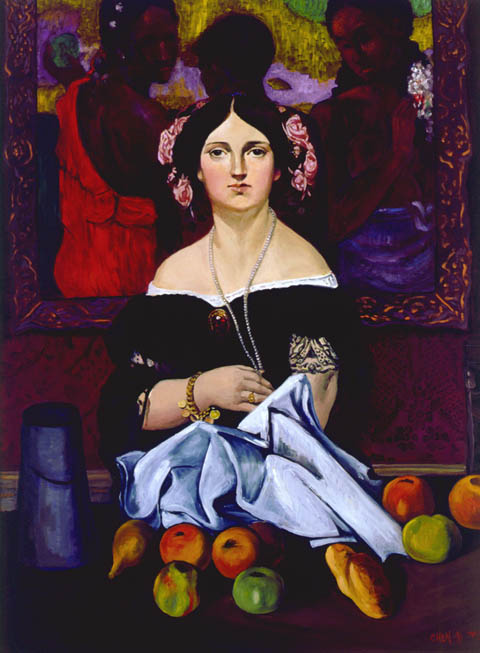
Dr. T. F. Chen: “Happy Mme. Moitessier,” 1993 screen print, 40x30.” Taken from 1992 o/c.
Between Cezanne’s still life and Gauguin’s Tahitian painting, Ingres’ “Mme. Moitessier” stands confident and serene. Her source of happiness is twofold: her portrait hangs in a museum, enchanting thousands; and she owns, within this frame of reference, two postimpressionist masterpieces. In linear time, this would be impossible, since both works were produced almost half a century after her death. But the imagination does not recognize the boundaries of time and space. This intriguing arrangement playfully revises history and demonstrates the depth of possibility in the postmodernist art world.Ingres: “Mme. Moitessier,” 1851, National Gallery of Art, Washington, D.C.
French painter Ingres was one of the artists who represented the height of the Neoclassical style of the Napoleonic period. He was renowned as a portraitist, and this is one of his finest works. The treatment of dessin, a French term indicating the representation of elements such as volume, light and shadow to give the appearance of three dimensions in a two-dimensional medium, was significant to the style. The Moitessiers were friends of Ingres—he knew the whole family—and were patrons as well.
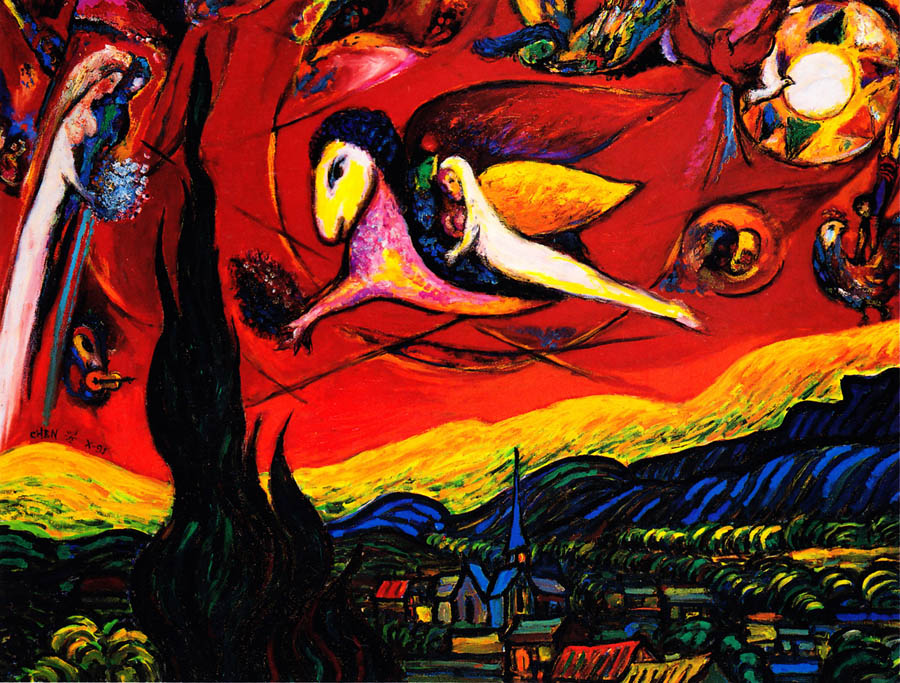
Wedding Above the Village / 77 X 101 cm / Print / 1991
The juxtaposition of complementary colors “the Chagall sky with the van Gogh landscape” excites the eye. When van Gogh painted Starry Night, he was lonely and unhappy, a victim of unrequited love who, more than anything, wished for a wife and family.Chagall’s exuberant Song of Songs images present a wish fulfillment: love, mutual bless, and evelasting joy. Although it was impossible on the physical plane to grant van Gogh a portion of happiness, through the merging of his work wih the transcendent sweetness of Chagall’s, Chen bestows a subconscious blessing. In a time out of time, and a place out of place, van Gogh can enjoy love and peace.


